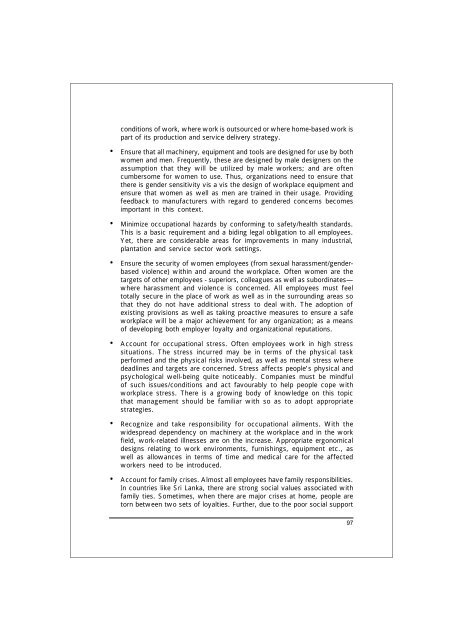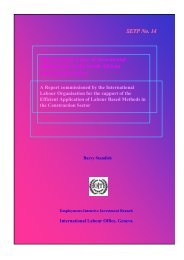Beyond Glass Ceilings and Brick Walls - International Labour ...
Beyond Glass Ceilings and Brick Walls - International Labour ...
Beyond Glass Ceilings and Brick Walls - International Labour ...
You also want an ePaper? Increase the reach of your titles
YUMPU automatically turns print PDFs into web optimized ePapers that Google loves.
conditions of work, where work is outsourced or where home-based work is<br />
part of its production <strong>and</strong> service delivery strategy.<br />
• Ensure that all machinery, equipment <strong>and</strong> tools are designed for use by both<br />
women <strong>and</strong> men. Frequently, these are designed by male designers on the<br />
assumption that they will be utilized by male workers; <strong>and</strong> are often<br />
cumbersome for women to use. Thus, organizations need to ensure that<br />
there is gender sensitivity vis a vis the design of workplace equipment <strong>and</strong><br />
ensure that women as well as men are trained in their usage. Providing<br />
feedback to manufacturers with regard to gendered concerns becomes<br />
important in this context.<br />
• Minimize occupational hazards by conforming to safety/health st<strong>and</strong>ards.<br />
This is a basic requirement <strong>and</strong> a biding legal obligation to all employees.<br />
Yet, there are considerable areas for improvements in many industrial,<br />
plantation <strong>and</strong> service sector work settings.<br />
• Ensure the security of women employees (from sexual harassment/genderbased<br />
violence) within <strong>and</strong> around the workplace. Often women are the<br />
targets of other employees - superiors, colleagues as well as subordinates—<br />
where harassment <strong>and</strong> violence is concerned. All employees must feel<br />
totally secure in the place of work as well as in the surrounding areas so<br />
that they do not have additional stress to deal with. The adoption of<br />
existing provisions as well as taking proactive measures to ensure a safe<br />
workplace will be a major achievement for any organization; as a means<br />
of developing both employer loyalty <strong>and</strong> organizational reputations.<br />
• Account for occupational stress. Often employees work in high stress<br />
situations. The stress incurred may be in terms of the physical task<br />
performed <strong>and</strong> the physical risks involved, as well as mental stress where<br />
deadlines <strong>and</strong> targets are concerned. Stress affects people’s physical <strong>and</strong><br />
psychological well-being quite noticeably. Companies must be mindful<br />
of such issues/conditions <strong>and</strong> act favourably to help people cope with<br />
workplace stress. There is a growing body of knowledge on this topic<br />
that management should be familiar with so as to adopt appropriate<br />
strategies.<br />
• Recognize <strong>and</strong> take responsibility for occupational ailments. With the<br />
widespread dependency on machinery at the workplace <strong>and</strong> in the work<br />
field, work-related illnesses are on the increase. Appropriate ergonomical<br />
designs relating to work environments, furnishings, equipment etc., as<br />
well as allowances in terms of time <strong>and</strong> medical care for the affected<br />
workers need to be introduced.<br />
• Account for family crises. Almost all employees have family responsibilities.<br />
In countries like Sri Lanka, there are strong social values associated with<br />
family ties. Sometimes, when there are major crises at home, people are<br />
torn between two sets of loyalties. Further, due to the poor social support<br />
97
















